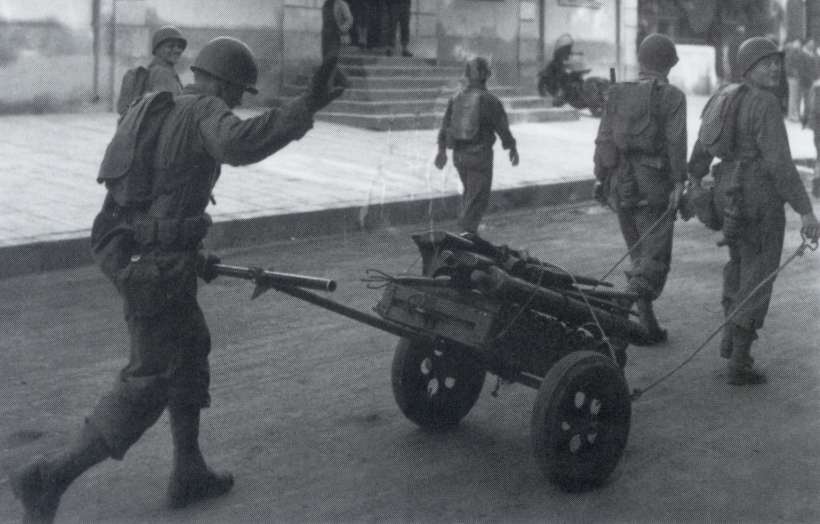Tactical movement of military stores and supplies to support foot-mobile or already dismounted infantry units and sub-units is a vital activity. It excludes the actual transport of such infantry.
When terrain and conditions permit, cargo can be well protected and provided to infantry by accompanying vehicles that are preferably armoured and optionally cross-country and amphibious. But in dense vegetation, rugged terrain and urban labyrinths most vehicle types become remote. Similarly airdrop or actual supply from aircraft and VTOLs is only sometimes usable and timely.
A particular concern for tactical deployment is that many smaller self-propelled surface vehicles such as 6x6 and 4x4 ATVs are also too large and/or heavy to accompany infantry in all conditions and also onto expedient transport such as utility helicopters and GS vehicles. The fallbacks are 3-wheel ATVs and 2-wheel cross-country bikes. The lightest of these have empty weights of about 80kgand can carry a load of up to 150kg and optionally pull a trailer. At any speed above walking pace the overall load has to include the weight of a rider.
Animal transport such as camel, dog, horse, mule, oxen can carry only small loads relative to body weight: typically less than 33%. Animals can tow somewhat larger loads relative to body plus cart weight. But only dogs can be expediently transported together with infantry in the smaller types of vehicles, boats or aircraft. And several dogs are needed to carry a one-man load. Also, regardless of any natural forage, all load-carrying and draft animals introduce needs for additional food-types and veterinary support.
The inevitable result is that even when small ATVs are available, conditions often require that infantry move their immediate tactical supplies in personal packs augmented by own unit portering. Since Roman times it has been known that infantry used as mules become less alert. Modern infantry on operations are often loaded with about 50kg of own equipment and sub-unit stores. And the trend is upward with increasing use of body armour, communication/reporting and surveillance systems demanded as much for political as for tactical needs.
S.L.A. Marshall is sometimes criticised as a drummer but he accurately summarised the situation and costs then and now: “From faulty appreciation of the logistical limits of the human carrier come the loss of tactical opportunity and the wastage of good manpower”. [The Soldier’s Load and the Mobility of a Nation”, Marine Corps Association, Quantico, 1965, p47]
Various man-powered cargo carriers have been used to reduce the need for man-packing. Above the snow-line infantry routinely use small cargo sleds. Elsewhere some use has been made of man-propelled wheeled cargo carriers but these have not been widely adopted. The basic types are briefly 1-wheel barrow, 2-wheel in-tandem bike, 2-wheel side-by-side buggey, 3-wheel and 4-wheel carts.
One-wheel barrow used by old-time gold prospectors to push/pull gear and provisions long distances across rough country. On uneven ground a barrow is awkward to handle with a load as small as 75kg. Monowheel included on 210kg mount of 106mm M40 Rcl Rifle was problematic even for a short distance.
Two wheel in-tandem bike used to supply NVA and VC over long distance earthen and corduroy tracks. Designed for hard surface roads but modified with extended handlebars and seat tube, pedals and chain discarded. Weighed 10 to 15kg and carried up to about 90kg of cargo when pushed by one and probably often two small-statured men.
Buggey with two side-by-side wheels used as actual mount for Russian HMG. Golf buggey style two stub-axle layout tested by British Army in 1950/60s as carrier for infantry mortars, and wire cage buggey with low straight-through axle bar simultaneously tested as carrier for mortar bombs. Both types referred to as 1st Infantry Division trolleys. In 2001 the Singaporean Army ran a competition for an all-terrain personal 27kg load carrier (with side-by-side wheels ?): result not publicised. US Army has reportedly tested a bulky all-terrain all-purpose cart-sled (ATACS) derived from UT-2000 mountain stretcher system.
Three and four-wheel carts assessed as relatively cumbersome and not further discussed.
In my view both types of 2-wheel carrier have useful potential. Using modern materials and cross country wheels and tyres it is easy to see a 2-wheel in-tandem pack bicycle weighing approx 10kg and able to carry a load of up to about 75kg. Such a bike with wire panniers and straps would be somewhat heavier than the framed packs needed to load equivalent cargo onto say two human mules. However the push/puller could readily lay down and take up a cargo bike instead of having to more slowly undo or attach an extra 37kg backpack. Also despite times when both push/pullers had to work together to get a pack bicycle over/around an obstacle, there would be other times when the pack bicycle could be moved by one. Such a pack bicycle could negotiate narrow tracks and be attached to aids such as a flying fox or a cable pull up/down a slope . It could also be transported on the side or across the back of a GS or armoured vehicle, on a small boat or upright on a helicopter skid. It would increase the risk posed by anti-personnel mines.
A 2-wheel side-by-side buggey would have many of the same attributes. When appropriately loaded fore and aft it would require less effort to keep upright. If kept small it could fairly readily traverse narrow tracks, would be easy to move on a cable run but less so on a flying fox and could bulk awkwardly when transported on the side or back of a vehicle, or on a boat or helicopter. It would increase the risk posed by anti-personnel mines. With a basic configuration similar to that of a tripod it might (with wheels adjusted or detached) also be usable as a weapon mount.
That is enough to survey the topic. Infantry could benefit by having one or two types of small man-powered utility carriers to carry stores and some crew-served weapons. The main carrier is envisaged as a bicycle with two wheels in tandem. The second is a golf buggey style with two side-by-side wheels that might also function as a weapons mount. So several questions.
What types of man-powered cargo carriers been tested or used recently ? With what results ?
Why aren’t wheeled man-powered cargo carriers already in widespread military use ?
What characteristics are needed to make such carriers acceptable/useful ?
Scale of issue: one per platoon weapon team, one per infantry section ?
Would 50 to 75kg be a useful and readily manoeuvrable load size ?
2-wheels in-tandem and/or side-by-side or something else ?

















 hehehe, That is a "Sparky" website pic..
hehehe, That is a "Sparky" website pic..


Bookmarks